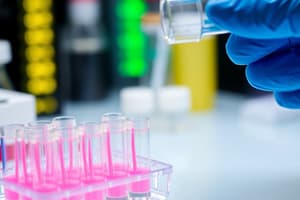Podcast
Questions and Answers
What is the primary purpose of Taq DNA polymerase in a PCR reaction?
What is the primary purpose of Taq DNA polymerase in a PCR reaction?
- To amplify the DNA and produce multiple copies (correct)
- To degrade unnecessary DNA fragments
- To provide a source of template DNA
- To stabilize the reaction mixture
Which components are necessary for PCR to occur?
Which components are necessary for PCR to occur?
- DNA templates, dNTPs, and two primers (correct)
- RNA primers and deoxynucleoside triphosphates
- Single-stranded DNA and DNA ligase
- Proteins and enzymes from bacteria
What is the typical length of PCR primers used in a reaction?
What is the typical length of PCR primers used in a reaction?
- 5 nucleotides
- 30 nucleotides
- 15 nucleotides
- 20 nucleotides (correct)
What role does the enzyme-linked immunosorbent assay (ELISA) serve in biological research?
What role does the enzyme-linked immunosorbent assay (ELISA) serve in biological research?
What is a characteristic feature of Taq DNA polymerase?
What is a characteristic feature of Taq DNA polymerase?
What type of DNA is synthesized during the PCR process?
What type of DNA is synthesized during the PCR process?
Which of the following statements about dNTPs is true?
Which of the following statements about dNTPs is true?
What is the primary purpose of PCR primers in a PCR reaction?
What is the primary purpose of PCR primers in a PCR reaction?
What characteristic of Taq DNA polymerase supports its usage in PCR?
What characteristic of Taq DNA polymerase supports its usage in PCR?
In ELISA, what role does a specific antibody play?
In ELISA, what role does a specific antibody play?
Which component is NOT typically used in PCR?
Which component is NOT typically used in PCR?
How many primers are used in each PCR reaction?
How many primers are used in each PCR reaction?
What is the main product of a successful PCR reaction?
What is the main product of a successful PCR reaction?
What is the role of deoxynucleoside triphosphates (dNTPs) in PCR?
What is the role of deoxynucleoside triphosphates (dNTPs) in PCR?
Which of the following describes the structure of PCR primers?
Which of the following describes the structure of PCR primers?
What characteristic of Taq DNA polymerase makes it suitable for PCR?
What characteristic of Taq DNA polymerase makes it suitable for PCR?
In the context of PCR, what is the significance of using two primers?
In the context of PCR, what is the significance of using two primers?
What distinguishes the enzyme-linked immunosorbent assay (ELISA) from other biochemical assays?
What distinguishes the enzyme-linked immunosorbent assay (ELISA) from other biochemical assays?
How does the amplification process occur in PCR?
How does the amplification process occur in PCR?
What is one of the primary applications of PCR in molecular biology?
What is one of the primary applications of PCR in molecular biology?
Which statement about Taq DNA polymerase is correct?
Which statement about Taq DNA polymerase is correct?
What is the role of dNTPs in the PCR process?
What is the role of dNTPs in the PCR process?
Which property of Taq DNA polymerase is crucial for its function in PCR?
Which property of Taq DNA polymerase is crucial for its function in PCR?
How does the use of two primers in PCR facilitate DNA amplification?
How does the use of two primers in PCR facilitate DNA amplification?
What is the main function of ELISA in biological research?
What is the main function of ELISA in biological research?
What is one advantage of using Taq DNA polymerase over other DNA polymerases in PCR?
What is one advantage of using Taq DNA polymerase over other DNA polymerases in PCR?
What characteristic of PCR primers is essential for their function?
What characteristic of PCR primers is essential for their function?
What is a common application of PCR in molecular biology?
What is a common application of PCR in molecular biology?
Why is the length of PCR primers typically around 20 nucleotides?
Why is the length of PCR primers typically around 20 nucleotides?
What role do dNTPs serve in the PCR process?
What role do dNTPs serve in the PCR process?
Why are two primers used in each PCR reaction?
Why are two primers used in each PCR reaction?
What is a significant advantage of using Taq DNA polymerase in PCR?
What is a significant advantage of using Taq DNA polymerase in PCR?
What is the role of PCR primers during the PCR process?
What is the role of PCR primers during the PCR process?
What distinguishes ELISA from other biochemical assays?
What distinguishes ELISA from other biochemical assays?
What is the main purpose of conducting PCR?
What is the main purpose of conducting PCR?
What is the typical outcome of a successful PCR reaction?
What is the typical outcome of a successful PCR reaction?
Which statement about the length of PCR primers is accurate?
Which statement about the length of PCR primers is accurate?
Flashcards are hidden until you start studying
Study Notes
Polymerase Chain Reaction (PCR)
- PCR uses the ability of DNA polymerase to synthesize a new DNA strand complementary to a template strand.
- PCR is used to amplify specific DNA segments.
- PCR Primers:
- Short single-stranded DNA chains (around 20 nucleotides)
- Two primers are used in each PCR reaction
- Deoxynucleoside Triphosphates (dNTPs):
- Four basic nucleotides (dATP, dCTP, dGTP, and dTTP)
- Building blocks of new DNA strands
- Taq DNA Polymerase:
- Amplifies DNA to produce multiple copies
- Thermostable, allowing it to function at high temperatures
Enzyme-Linked Immunosorbent Assay (ELISA)
- An immunoassay used to detect and quantify antigens or antibodies in a sample.
- Involves capturing a target antigen or antibody using a specific antibody or antigen.
- Target molecule detection/quantification is achieved using an enzyme reaction with a specific substrate.
Polymerase Chain Reaction (PCR)
- PCR is a molecular biology technique that amplifies specific DNA segments.
- PCR utilizes the ability of DNA polymerase to create a new strand of DNA complementary to a template strand.
PCR Components
- PCR Primers: Short, single-stranded DNA sequences (around 20 nucleotides) used to initiate DNA synthesis. Two primers are used in each PCR reaction.
- Deoxynucleoside Triphosphates (dNTPs): Building blocks for the new DNA strands. They consist of four basic nucleotides: dATP, dCTP, dGTP, and dTTP.
- Taq DNA Polymerase: A thermostable enzyme that amplifies DNA by synthesizing multiple copies. Taq polymerase works at high temperatures.
PCR Applications
- PCR is used in various fields, including:
- Genetic Testing: Detecting specific genetic mutations or variations
- Forensic Science: Amplifying and identifying DNA from crime scenes
- Medical Diagnosis: Identifying infectious agents or genetic diseases
- Research: Studying gene expression, DNA replication, and evolution
ELISA (Enzyme-Linked Immunosorbent Assay)
- ELISA is a technique used to detect and quantify specific antigens or antibodies in a sample.
- ELISA utilizes an antigen-antibody reaction to capture and then detect a target molecule.
- ELISA employs an enzyme-substrate reaction to generate a measurable signal, allowing for quantification of the target molecule.
Types of ELISA
- Direct ELISA: Detects the presence of an antigen directly by using an enzyme-linked antibody that binds to the antigen.
- Indirect ELISA: Detects the presence of an antibody by using a secondary antibody that binds to the primary antibody, which is bound to the antigen.
- Sandwich ELISA: Detects the presence of an antigen by using two antibodies: one that captures the antigen and another that binds to a different epitope of the antigen.
ELISA Applications
- ELISA is used in various fields, including:
- Diagnosis: Determining the presence of antibodies or antigens for infectious diseases, allergies, or autoimmune disorders.
- Food Safety: Detection of foodborne pathogens, allergens, or residues.
- Drug Development: Measuring drug concentrations in blood or urine.
PCR (Polymerase Chain Reaction)
- PCR utilizes DNA polymerase's ability to synthesize DNA strands complementary to a template strand.
- PCR is a widely used molecular biology technique for creating multiple copies of specific DNA segments.
- PCR Primers: Short single-stranded DNA sequences, typically around 20 nucleotides long. Two primers are used in each PCR reaction.
- Deoxynucleoside Triphosphates (dNTPs): The building blocks for new DNA strands. Consists of four nucleotides: dATP, dCTP, dGTP, and dTTP.
- Taq DNA Polymerase: A thermostable enzyme that amplifies DNA by creating multiple copies. Taq DNA polymerase functions at high temperatures.
ELISA (Enzyme-Linked Immunosorbent Assay)
- ELISA is a method for capturing target antigens (or antibodies) in samples using a specific antibody (or antigen).
- ELISA detects and quantifies target molecules using an enzyme reaction with its substrate.
- ELISA 96 Well Plate: Uses multiple wells for performing the assay.
Polymerase Chain Reaction (PCR)
- A molecular biology technique to produce multiple copies of a specific DNA segment.
- PCR relies on the ability of DNA polymerase to synthesize a new DNA strand complementary to a provided template.
PCR Components
- PCR primers: Short single-stranded DNA chains, typically around 20 nucleotides long. Two primers are used per PCR reaction.
- Deoxynucleoside triphosphates (dNTPs): Four basic nucleotides (dATP, dCTP, dGTP, and dTTP) used as building blocks for new DNA strands.
- Taq DNA polymerase: Thermostable enzyme that amplifies DNA by creating multiple copies. Taq polymerase can function at high temperatures.
PCR Gel Electrophoresis
- Visualizes PCR results by separating DNA fragments based on size.
- Positive: Indicates the presence of the target DNA sequence.
- Negative: Indicates the absence of the target DNA sequence.
Enzyme-Linked Immunosorbent Assay (ELISA)
- A method for capturing and quantifying target antigens or antibodies in samples.
- Uses specific antibodies or antigens to capture the target molecule.
- Detects and quantifies the target molecule using an enzyme reaction with its substrate.
PCR
- PCR uses DNA polymerase to synthesize new DNA strands
- PCR amplifies specific DNA segments
- PCR utilizes two primers, each about 20 nucleotides long
- PCR utilizes deoxynucleoside triphosphates (dNTPs) which are the building blocks of new DNA strands
- PCR utilizes Taq DNA polymerase because it is thermostable and can function at high temperatures
ELISA
- ELISA is a method for target antigen (or antibody) capture in samples using a specific antibody (or antigen)
- ELISA uses an enzyme reaction to detect and quantify target molecules
Studying That Suits You
Use AI to generate personalized quizzes and flashcards to suit your learning preferences.




